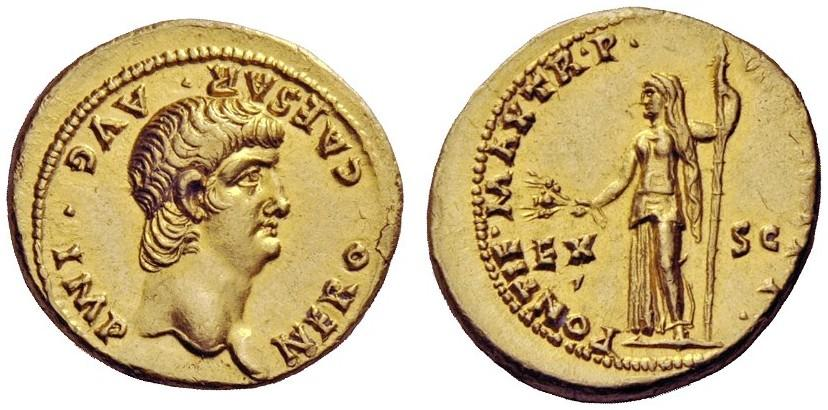Emergency Issues, Reforms, and the Beginnings of the Civil War
In 57 AD emperor Nero prevented the senate from issuing coinage and took hold of the Roman treasury for his personal gain. This was so Nero could be able to tax the Roman people to fund his golden palace. Nero increased the volume of taxed goods through trade, while limiting the direct tax. However, after a short period of time and a complete disaster with funding and the economy, the Roman senate stepped in and appealed the new tax reform. To Nero's dismay, he decided a complete reformation of coinage was necessary to meet the goals of the economy and his personal benefit.

Aureus Celebrating the death of Nero, ca. October AD 70
Courtesy of Kuenker
The most important initiative in Nero's monetary reform took place in the years 63/64 AD. In this first act, the Denarius and Aureus were decreased in weight and fineness. The purity of the Denarius, especially, fell from 98% to nearly 93% pure. Nero issued his reform of bronze coinage shortly after, replacing most of the lower valued bronze coins with orichalcum and added the radiate, or spiked crown to the Dupondius of ½ Sestertii (similar in size to the Sestertius) in order to distinguish the two types. The economy was relatively revitalized by this coinage reform, as it placed each denomination in a very organized position that made coins easy to spend.
It is curious, however, when examining the true reason behind this monetary reform. In the year 64 AD, Rome was engulfed in the infamous Great Fire, and though the accusation that Emperor Nero instigated the blaze or fiddled through its chaos has never been substantiated, historian Tacitus asserts that Nero was not even present in Rome at the time but rather in his hometown, the coastal city of Antium. Upon his return, Nero initiated relief efforts, funding shelters for the displaced from his personal resources. However, his reign took a dark turn as he orchestrated the murders of his mother and two of his wives. Expanding his influence, Nero claimed a significant portion of Rome for himself. It wasn't until Vespasian ascended to power that the tide turned. Vespasian demolished Nero's palace and returned the seized property to the Roman people. In the very space where Nero's extravagant palace once stood, Vespasian commissioned the construction of the iconic Colosseum, a symbol of a new era and a testament to the resilience of Rome. But this palace, the very symbol that represented the entirety of Nero’s reign, was funded by the reform of gold coinage.
Based on contemporary metallurgy and modern analysis, the Aureus seemed to decrease in weight and purity, whereas the denarius and bronze coinage were slightly affected. The Quinarius Aureus (or Halbaureus), issued to be circulated in the east, had also experienced a drastic change. The Aureus during the reign of Nero had a value of around 25 silver Denarii, with the weight of the coin stagnant at around 7.70 grams of gold. The Halbaureus stayed at around 3.80-4.00 grams. Nero decreased the purity of his Aureus to around 90-95% pure instead of the typical 97-99% purity. This slight change was not as apparent to the Roman people when compared with the slight weight change. Coinage issued after Nero’s financial reform were 7.27 grams per Aureus and 3.64 grams per Halbaureus.
Nero's palace stood as the pinnacle of grandeur, dominating the heart of the city and encircling the Imperial forum. Inside, it boasted an opulence unmatched, adorned with rare jewels, priceless Greek antiquities reflecting Nero's fixation on the Golden Age of Greece, and emblematic representations of the empire's might. A colossal golden statue portraying Nero as Helios adorned the palace, eventually relocated outside the Flavian Amphitheater after a makeover. Even in modern times, the palace's foundation endures, harboring an intricate substructure of waterways. These channels fed an artificial lake linked to Nero's residence, a reservoir instrumental in staging the famed naval battles within the Colosseum. Following Nero's downfall and the cessation of civil unrest, Vespasian returned the estate to the Roman populace, albeit at the cost of debased coinage, ushering in an era of prosperity for Rome
It seems that Nero’s first gold coin was an Aureus minted in 51 AD, featuring the bust of Claudius on the obverse and the bust of Young Nero on the reverse. This issue was minted until 54 AD, where it was replaced with a conjoined bust issue which appears to be a one year type in 54 AD. Nero became Caesar in 50 AD, perhaps this issue was to commemorate Claudius granting him this title, whilst his Emperorship (or Augustus) began in 54 AD.

First coin of Nero upon his Caesarship, ca 51 AD
Courtesy of NAC
The initial appearance of the confronted busts of Emperor Nero and his mother Agrippina marks the first instance during his rule where Nero's likeness is portrayed. This portrayal is distinguished by the legend TR P, indicating its creation in AD 54. Conversely, coins displaying the combined busts of Nero and Agrippina bear the legend TR P COS, signifying their production in AD 55. Notably, a particular obverse die of this coin exhibits a leaf (or possibly a grain kernel) positioned behind Nero's bust. Merely six known examples of this coin exist, and the precise significance of this particular obverse design remains uncertain. Moreover, this depiction is also present on aurei coins featuring Nero's combined busts and on aurei featuring Divus Claudius.

Conjoined busts, ca. 54 AD
Courtesy of Maison
The young bust of Nero began minting around 51-52 AD, and shows a very youthful portrait of the emperor. With an inscribed shield. Nero also minted a posthumous issue of Claudius dating to around 54 AD, featuring the left-facing portrait of Divus claudius. There were also other various deity issues in this period, most notably being Jupiter, Libertas, Ceres, Mars, and Roma on the reverse. All issues are uncommon with Nero’s middle-type bust.

First coin of nero’s Augutsuship, ca 54 AD with the inscribed shield EQVESTER / OR – DO / PRINCIPI / IVVENT
Courtesy of NAC
As Nero grew up, his portrait became much more fierce. One of his more famous issues was a reverse design within an oak wreath, minted in Rome and Lugdunum in 55 AD initially, then ending in 61 AD. Nero is more grown up, the style of the portrait is much more realistic, and Nero has gained a significant amount of weight. The wreath issue is slightly heavier than the shield issue, with examples commonly having a 0.30 gram difference. It is unknown why this weight difference occurs, as examples from both the Rome and Lugdunum mint experience this change.

Oak wreath, ca. 56-61 AD
Courtesy of NAC
Nero issued an Aureus with a younger facing bust in 51 AD, with a Lituus and Simpulum on the reverse. Nero halted the mintage of this type in 54 AD. It seems that the mint in Lugdunum began minting this type again after 54 AD, but this time with the older portrait of Nero. It is uncertain whether a certain event sparked this mysterious mintage or if there was a lack of dies being used so old dies were refurbished with newer obverses. Calico 441b claims this issue was minted in 54 AD, but the portrait (which is facing left) matches the issues after 60 AD.

Young bust, ca. 51-54 AD

Old bust, presumably struck after ca. 60 AD (54 AD?)
Nero only minted a few coins in the timespan of 62-63 AD, presumably because the emperor was preoccupied with other matters. The final coin before the monetary reform is a type struck in 63 AD with Roma placing her foot on a cuirass. His reform in 64 AD saw the drastic change in portraiture. Nero is more realistic, fatter, with more facial hair. He also rarely faces left, as left facing portraits and the left hand had become a taboo in Roman culture during this period. Nevertheless, Nero has gotten significantly uglier after his reform, partially because the monetary reform probably had dies engraved with the newer likeness of the Emperor. Nero was also the last emperor to be depicted with a beard until Hadrian in 138 AD.
The most common coin of Nero is probably the first coin that came out of the reform. It is a widespread issue, minted in Rome and Lugdunum with many varieties. The reverse has Salus seated holding a patera, and this coin was minted until Nero’s death in 68 AD. The earliest issues are distinctly lighter, and have a thinner portrait of him (Calico 443). It was an issue that saw heavy circulation in the east, most examples are not in high grade.

Salus, ca. 64 AD
Courtesy of Aurea Numis.
Nero’s last coin was perhaps minted from 64-68 AD, but it is likely that it was minted during the mintage of the Salus type. It features the hexastyle temple of vesta, which still resides in Rome to this day. The last issue in 68 AD the temple appears slightly larger than its predecessors, with the legend VESTA surmounting.

The Temple of Vesta, ca. 64-68 AD
Courtesy of CNG
In 68 AD, Nero’s Praetorian guard abandoned him. He was forced to flee the city, escaping his soon to be demise. Nero fled Rome into the outskirts, by Ostia. According to Suetonius, he was aware of the ensuing mob against his authority, as his final words were "Too late! This is fidelity!". He died on 9 June 68 AD by stabbing himself in the throat. He was cremated and buried in the Mausoleum of the Domitii Ahenobarbi, in what is now the Villa Borghese (Pincian Hill).
The demise of Nero created a power vacuum in Rome. There were no descendants left of the caesarian dynasty, so the power had to go to someone who was supported by Nero, which he had no heir. The first man to step up was general Galba, who marched into Rome after being declared emperor by his troops. This compromise began in the year of the four emperors, in which four men (Galba, Otho, Vitellius, Vespasian) were declared emperor with only Vespasian surviving. In this period, the unofficial emperors minted their own coinage, either to pay their troops or to place their legacy on coinage in such a brief moment of time. Civil war issues also exist, which are a vast span of anonymous Aurei, featuring the deity on the obverse and a signet or symbol on the reverse. Most of the civil war Aurei and Denarii were minted in Gaul.

Civil War Aureus, ca. 69 AD
Courtesy of Leu

Civil War Aureus, ca. 68 AD
Courtesy of NAC
Article By Colby J. Abele

